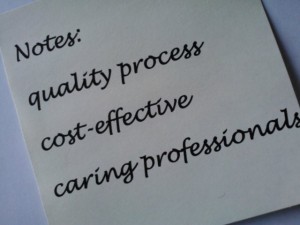
“I hope we can be friends.” This is not an uncommon wish of one or both people when going through a divorce. Sometimes, however, there is a lot of pain and anguish going on for at least one of them and significant negative energy between the couple. “How did we get like this?” is another frequent question I hear in my practice. So how do we answer the question and can you become friends? It is helpful to think about how relationships develop in order to answer the question. I heard Isolina Ricci, speak to a group of mental health professionals and attorneys about her research around divorce and families a couple years ago. She introduced a very helpful concept that I often share with clients to help them understand whether and how they can be friends.
When we meet people, we start with a business relationship. We use more formal language, make few assumptions, make clear agreements, have minimal expectations and are not very attached to or invested in the relationship.
Ricci notes that we are private, explicit, cool and reserved. As we get to know someone and move to friendship, we are less formal, begin to make assumptions and have expectations and are therefore more invested in the relationship. When the relationship becomes intimate, we become very informal with each other, act based on assumptions formed from past experiences with the individual, give the benefit of the doubt, and are very invested in the relationship. Ricci notes that we are vulnerable, implicit, hot and intense.
However, when we reach the point of divorce, the relationship has moved from one of positive intimacy to negative intimacy. We move from the positive qualities of intimacy to the opposite of those qualities, (i.e., shared to abused confidences, loyalty and trust to disloyalty and distrust, positive assumptions to negative assumptions, benefit-of-doubt to suspicion and blame, for example). What we need to realize is that when we are in a place of negative intimacy, we cannot simply go back to friendship. In order to become friends, we need to move from negative intimacy back to the business relationship and then rebuild to friendship from there. Ricci calls this the
detox-negative-intimacy, where we reset to a business-like relationship.
In the
Collaborative process, we actually help people learn how to step back to the business relationship by modeling respectful communication, not make assumptions but ask questions to clarify, strive to be trustworthy, make clear agreements, create healthy boundaries relating to times and means of communication, and sticking to facts rather than being emotionally reactive. And this is very hard work! But, by making the intentional effort to go back to a business relationship, we can start rebuilding trust by honoring agreements, getting rid of unproductive assumptions by asking clarifying questions, and redeveloping a give-and-take relationship. Over time, it is possible to create a business like friendly relationship.
 Many recovering alcoholics claim that the wisdom of The Serenity Prayer saved their life. I have found in my practice that the wisdom contained in this simple prayer can also serve as an essential guide for helping people through a difficult divorce.
The Serenity Prayer, which asks for the serenity to accept the things you cannot change; the power to change the things you can and the wisdom to know the difference, provides an important framework for dealing with almost all difficult situations.
Divorce almost always creates unfortunate realities that lie outside our control; the fact that you will not see your children on certain days; the reality that your family income will now be spread through two homes; and many other stubborn truths. These realities cannot be changed and, in the end, the ability to find acceptance and serenity is a worthy goal.
Divorce also requires people to summon courage to address daunting challenges; finding ways to co-parent when you are angry or scared; learning to manage new financial challenges; or trying to communicate effectively in painful situations. People who find this courage in divorce are much more likely to achieve their goals.
Finally, gaining wisdom about which areas need acceptance and which challenges require us to act courageously is often the ultimate challenge in a divorce. While some of this wisdom may come from divorce sources, some of the wisdom can be gathered by finding people you can trust to help you focus your time and energy on your most important goals.
One thing I like about the Collaborative Divorce Process is the focus on giving people the tools they need to truly help themselves. The first step in the process is generally to help clients identify their highest goals. As the process evolves divorcing couples are counseled to accept the things beyond their control so that they can focus their attention and limited resources on the things that truly matter. Clients who truly commit themselves to these principles can move from chaos to a new sense of order; sometimes even a deep sense of serenity. In any case, I have found that giving people the opportunity to gain wisdom about when to “let go” and when to work for change is the most important part of a divorce attorney’s job.
Many recovering alcoholics claim that the wisdom of The Serenity Prayer saved their life. I have found in my practice that the wisdom contained in this simple prayer can also serve as an essential guide for helping people through a difficult divorce.
The Serenity Prayer, which asks for the serenity to accept the things you cannot change; the power to change the things you can and the wisdom to know the difference, provides an important framework for dealing with almost all difficult situations.
Divorce almost always creates unfortunate realities that lie outside our control; the fact that you will not see your children on certain days; the reality that your family income will now be spread through two homes; and many other stubborn truths. These realities cannot be changed and, in the end, the ability to find acceptance and serenity is a worthy goal.
Divorce also requires people to summon courage to address daunting challenges; finding ways to co-parent when you are angry or scared; learning to manage new financial challenges; or trying to communicate effectively in painful situations. People who find this courage in divorce are much more likely to achieve their goals.
Finally, gaining wisdom about which areas need acceptance and which challenges require us to act courageously is often the ultimate challenge in a divorce. While some of this wisdom may come from divorce sources, some of the wisdom can be gathered by finding people you can trust to help you focus your time and energy on your most important goals.
One thing I like about the Collaborative Divorce Process is the focus on giving people the tools they need to truly help themselves. The first step in the process is generally to help clients identify their highest goals. As the process evolves divorcing couples are counseled to accept the things beyond their control so that they can focus their attention and limited resources on the things that truly matter. Clients who truly commit themselves to these principles can move from chaos to a new sense of order; sometimes even a deep sense of serenity. In any case, I have found that giving people the opportunity to gain wisdom about when to “let go” and when to work for change is the most important part of a divorce attorney’s job.  Many recovering alcoholics claim that the wisdom of The Serenity Prayer saved their life. I have found in my practice that the wisdom contained in this simple prayer can also serve as an essential guide for helping people through a difficult divorce.
The Serenity Prayer, which asks for the serenity to accept the things you cannot change; the power to change the things you can and the wisdom to know the difference, provides an important framework for dealing with almost all difficult situations.
Divorce almost always creates unfortunate realities that lie outside our control; the fact that you will not see your children on certain days; the reality that your family income will now be spread through two homes; and many other stubborn truths. These realities cannot be changed and, in the end, the ability to find acceptance and serenity is a worthy goal.
Divorce also requires people to summon courage to address daunting challenges; finding ways to co-parent when you are angry or scared; learning to manage new financial challenges; or trying to communicate effectively in painful situations. People who find this courage in divorce are much more likely to achieve their goals.
Finally, gaining wisdom about which areas need acceptance and which challenges require us to act courageously is often the ultimate challenge in a divorce. While some of this wisdom may come from divorce sources, some of the wisdom can be gathered by finding people you can trust to help you focus your time and energy on your most important goals.
One thing I like about the Collaborative Divorce Process is the focus on giving people the tools they need to truly help themselves. The first step in the process is generally to help clients identify their highest goals. As the process evolves divorcing couples are counseled to accept the things beyond their control so that they can focus their attention and limited resources on the things that truly matter. Clients who truly commit themselves to these principles can move from chaos to a new sense of order; sometimes even a deep sense of serenity. In any case, I have found that giving people the opportunity to gain wisdom about when to “let go” and when to work for change is the most important part of a divorce attorney’s job.
Many recovering alcoholics claim that the wisdom of The Serenity Prayer saved their life. I have found in my practice that the wisdom contained in this simple prayer can also serve as an essential guide for helping people through a difficult divorce.
The Serenity Prayer, which asks for the serenity to accept the things you cannot change; the power to change the things you can and the wisdom to know the difference, provides an important framework for dealing with almost all difficult situations.
Divorce almost always creates unfortunate realities that lie outside our control; the fact that you will not see your children on certain days; the reality that your family income will now be spread through two homes; and many other stubborn truths. These realities cannot be changed and, in the end, the ability to find acceptance and serenity is a worthy goal.
Divorce also requires people to summon courage to address daunting challenges; finding ways to co-parent when you are angry or scared; learning to manage new financial challenges; or trying to communicate effectively in painful situations. People who find this courage in divorce are much more likely to achieve their goals.
Finally, gaining wisdom about which areas need acceptance and which challenges require us to act courageously is often the ultimate challenge in a divorce. While some of this wisdom may come from divorce sources, some of the wisdom can be gathered by finding people you can trust to help you focus your time and energy on your most important goals.
One thing I like about the Collaborative Divorce Process is the focus on giving people the tools they need to truly help themselves. The first step in the process is generally to help clients identify their highest goals. As the process evolves divorcing couples are counseled to accept the things beyond their control so that they can focus their attention and limited resources on the things that truly matter. Clients who truly commit themselves to these principles can move from chaos to a new sense of order; sometimes even a deep sense of serenity. In any case, I have found that giving people the opportunity to gain wisdom about when to “let go” and when to work for change is the most important part of a divorce attorney’s job. 



 Is Calvin right? How would you describe a good compromise? Does it leave everybody mad? Is a compromise that leaves anybody mad really a good one? I don’t thinks so.
Generally speaking, there are two recognized methods of negotiation:
Is Calvin right? How would you describe a good compromise? Does it leave everybody mad? Is a compromise that leaves anybody mad really a good one? I don’t thinks so.
Generally speaking, there are two recognized methods of negotiation:



